3 of the Best Food Experiences in Wicklow's Great Houses
Kate Ryan, Flavour.ie; images courtesy of Kate Ryan
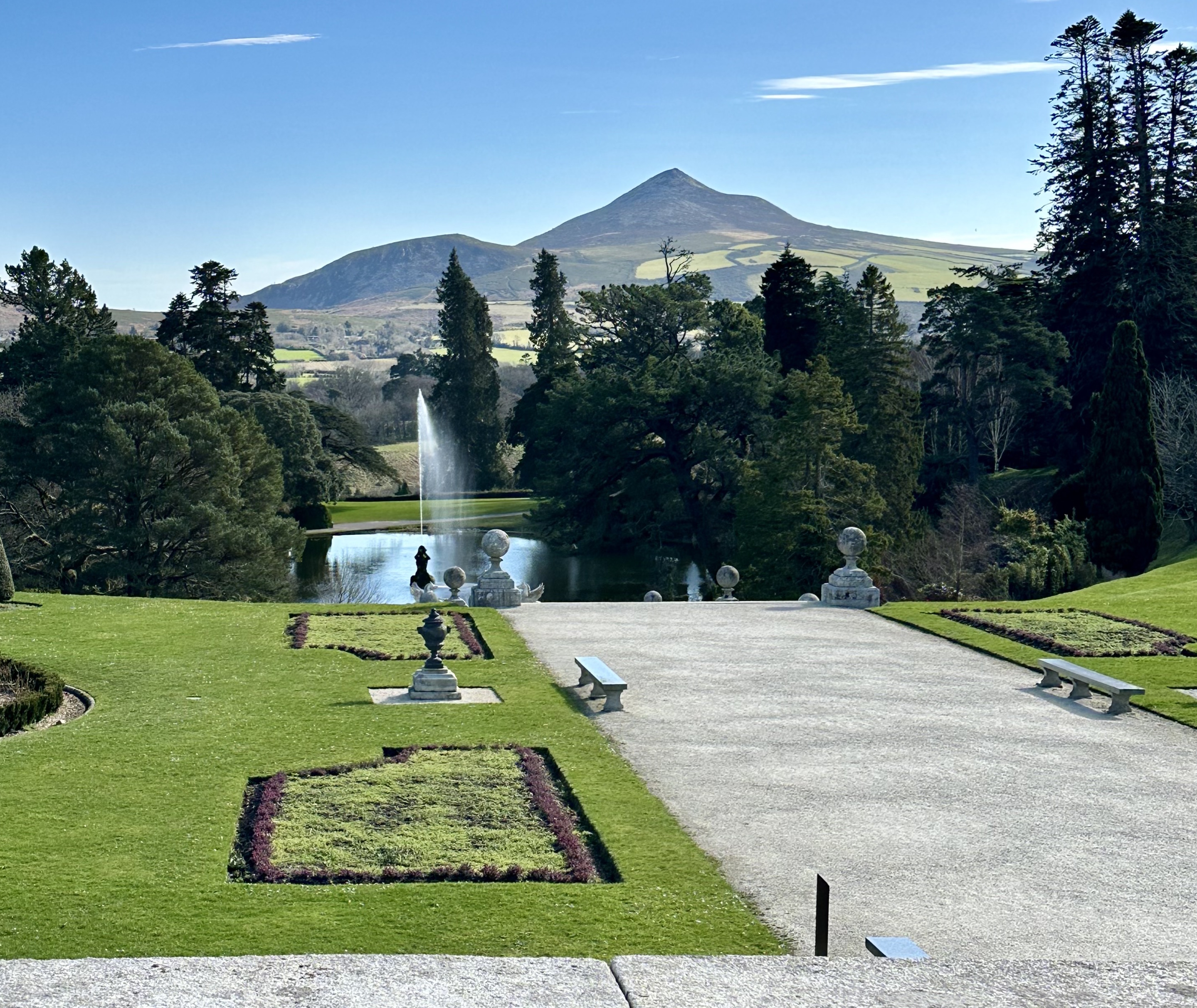 County Wicklow has a well-deserved reputation as the Garden of Ireland, a moniker bestowed for the county’s unusual concentration of historic houses and their beautifully landscaped gardens. The county boasts epic wild scenery gifted by the ruggedness of the Wicklow Mountains, the timelessness of Glendalough and its national park.
County Wicklow has a well-deserved reputation as the Garden of Ireland, a moniker bestowed for the county’s unusual concentration of historic houses and their beautifully landscaped gardens. The county boasts epic wild scenery gifted by the ruggedness of the Wicklow Mountains, the timelessness of Glendalough and its national park.
Among the riches of the built heritage of County Wicklow’s great houses, a few are publicly accessible and have made great efforts to recentre themselves within their community. They are custodians of a side of Irish history that is complex – hundreds of years of colonial rule, landed gentry and hereditary titles rub uneasily beside the spectre of famine and poverty. But while it is true that some of history’s landlords are ill-remembered, this is not the case for all.
Operation of these vast Wicklow estates was possible only by the labour of local people. One Wicklow native I spoke to can trace their family’s working roots on the Powerscourt Estate back several generations, including themselves, and remembers the estate being an ever-present part of their childhood with great fondness. Meanwhile, in Killruddery House, letters have been found in old archives from famine times detailing instructions to estate gardeners to collect seeds from vegetables that could be grown when potatoes could not, to package them up and gift them to as many people as possible to reestablish the small kitchen gardens kept for self-sufficiency.
This is not a worldview that will win everyone over, and that is important too. History is made of both the good and bad, and to remember both is essential for ensuring the past is remembered in accordance with the different experiences of all kinds of people.
Notwithstanding, Ireland’s historic houses play an essential role in preserving history. The houses and estates are custodians of multiple facets of heritage, history and tradition, and were often pioneers in embracing new-fangled fashions which, over time, trickled through layers of society to become enmeshed in customs and bound into a culturally Irish way of life.
It was prized among these great estates to be as self-sufficient as possible – certainly in relation to food, but also in leisurely pursuits. Collecting treasures such as art, sculpture and books fed the mind while pursuits such as fishing, hunting, boating, flower gardens and parklands had a more corporeal function. Growing and producing food was vital to these estates. Farming was often a source of income via tillage, beef and dairy. The growing of vegetables, fruits and herbs, the keeping of livestock and poultry and lakes stocked with trout and perch were not only essential for keeping an estate fed and watered but also a status symbol. To be entirely served by the estate demonstrated its bountifulness and attested to how well it was run and, ultimately, an estimation of its value. These were not just grand and pretty houses!
Today, three of Wicklow’s great houses are embracing food as a way to meet a new generation of visitor. They say food is the great leveller, so there is a logic to the likes of Killruddery, Powerscourt and Russborough offering a place to break bread as an enticement to explore the hundreds of years of history built up within their walls.
POWERSCOURT ESTATE (North County Wicklow)
www.powerscourt.com
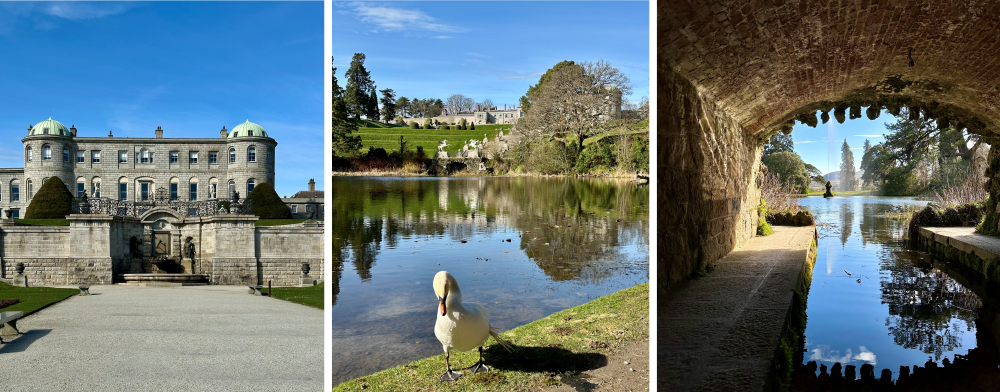
The Powerscourt Demesne itself encompasses the historic house and gardens, the site of Powerscourt Whiskey Distillery and Visitors’ Experience, Powerscourt Garden Centre, Powerscourt Hotel and Powerscourt Waterfall. Some 851 acres in total.
Only a small portion of the house (now owned by the Slazenger family of sports equipment fame) is open to the public which includes a selection of curated retail experiences encompassing interiors, arts and crafts, and an Avoca store which carries a great selection of Wicklow-made artisan food and drink items – perfect for a last-minute picnic in the gardens. Avoca also run the café on site which includes a marvellous terrace overlooking the sweeping staircase, lawns, woodland and ever-present Sugarloaf Mountain that make up just some of the 47 acres of stunning gardens. The café is open year-round serving light bites from soup to hearty bakes, and a daily selection of freshly baked scones, cakes and pastries.
Adjacent to the main house is Powerscourt Distillery located inside an old mill house dated back to the 1700s. The building has been lovingly restored, and where original pieces of mill machinery were uncovered, have been preserved to enhance the heritage story of the building. Outside the main entrance, the original farm bell still hangs; silent now, but a reminder of a time before watches when the daily work was measured out by its tolling.
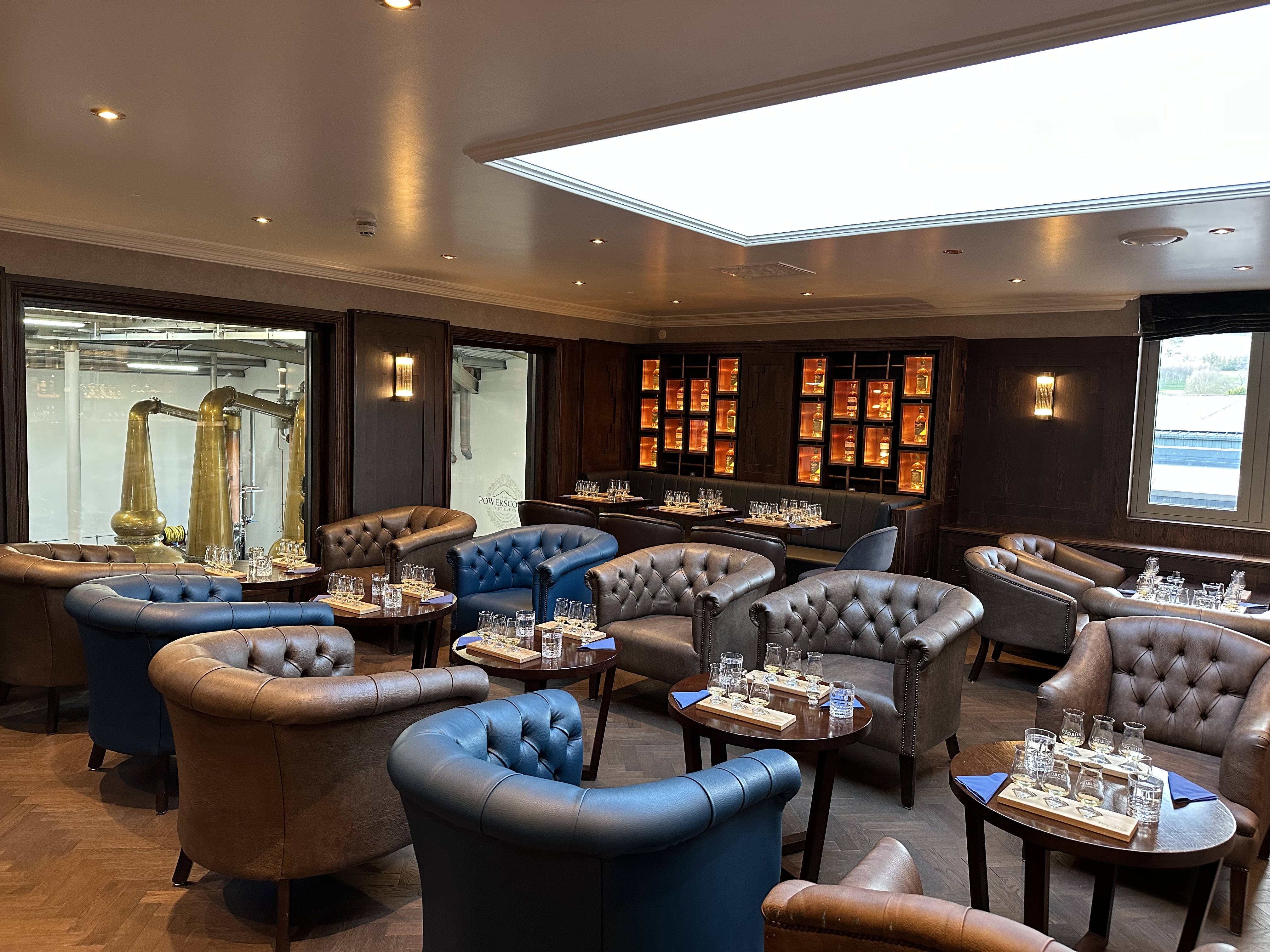 The impressive trio of pot stills was crafted by Forsythe in Scotland. Currently, the distillery has capacity to produce 300k litres of new make spirit but was built with future expansion in mind – if required, production could be ramped up to a million litres per year!
The impressive trio of pot stills was crafted by Forsythe in Scotland. Currently, the distillery has capacity to produce 300k litres of new make spirit but was built with future expansion in mind – if required, production could be ramped up to a million litres per year!
The distillery laid down its first batch of new make spirit in 2018, which means the oldest pot to bottle Irish whiskey here is a seven-year-old blended whiskey – Fercullen. Malt and pot still whiskeys are made on site and the Fercullen brand range includes malt, grain and blended spirits.
The distillery is fed from pure spring water, and annually 300 tonnes of barley used is sourced from the Powerscourt Estate farmlands with additional barley sourced further afield within the county. In addition, the distillery is pushing the envelope in terms of creating ever more unique flavour profiles in their whiskey to create a true taste of place through experimentation with heritage Irish oak and wild cultivated yeast.
 The distillery has secured access to a small number of windfallen oak trees from a nearby heritage Irish oak forest which has been in existence for close to 500 years. During storms in 2024, a small number of these oak trees fell and, with permission, the distillery salvaged the wood. It is currently being seasoned in Champagne, France (the region, not the wine) and eventually will return to Ireland and sent to a cooperage to be transformed in virgin Irish oak barrels for storing and maturing new make whiskey spirit.
The distillery has secured access to a small number of windfallen oak trees from a nearby heritage Irish oak forest which has been in existence for close to 500 years. During storms in 2024, a small number of these oak trees fell and, with permission, the distillery salvaged the wood. It is currently being seasoned in Champagne, France (the region, not the wine) and eventually will return to Ireland and sent to a cooperage to be transformed in virgin Irish oak barrels for storing and maturing new make whiskey spirit.
In the whiskey world, the use of wood to impart flavour and character is still a burgeoning area of exploration for whiskey makers. For Irish whiskey to be called so, it must rest in barrels for a minimum three years and a day. Most whiskey is matured in ex-bourbon American oak, and because Irish oak is protected and therefore rare, the prospect of access to a small amount of this wood is the stuff of dreams to whiskey makers.
The final frontier is the cultivation of a wild yeast. Most Irish whiskeys used one or two commercially available brewers’ yeast which feeds off the natural sugars in the mash during fermentation. The distillery team has paired up with Technological University Dublin to propagate a wild yeast strain captured from the estate. If the trial is a success, Powerscourt Distillery will be the first to produce a true single estate Irish whiskey from water, grain, yeast, spirit and wood all from Powerscourt Estate.
As exciting as this is, we must all cool our hooves a little! Irish Whiskey is a slow process, so even when every element is ready, we will still have to wait at least the obligatory three years and a day to taste the results of this endeavour.
 In the meantime, Powerscourt Distillery has relaunched its distillery tours for the coming season and they have also reopened their tasting room for their signature Tasting Experiences in the beautifully appointed whiskey lounge.
In the meantime, Powerscourt Distillery has relaunched its distillery tours for the coming season and they have also reopened their tasting room for their signature Tasting Experiences in the beautifully appointed whiskey lounge.
Daily tours include the Ultimate Irish Whiskey Experience (1 hour, €25pp) or the literally sensational Fercullen Irish Whiskey and Artisan Food Pairing (1.5 hour, €45pp). If you’ve seen enough distilleries in your time and you just wish to taste a selection of whiskeys, choose from a Standard Whiskey Tasting (3 samples, €15), Premium Whiskey Tasting (€55, includes rare and limited-edition whiskeys), or opt for a bespoke whiskey cocktail from the Mixology Menu.
KILLRUDDERY HOUSE (Bray, East County Wicklow)
www.killruddery.com

Killruddery House is an exceptional example of an historic house that has truly leaned into providing a gateway for experiencing the property through the promotion of good, local food. The house itself has been in the Brabazon family since 1618 with the current generation Anthony Brabazon and his wife Fionnuala incredibly hands on in all aspects of the estate, leveraging everything the house, gardens and farm have to offer.
As well as tours of the house during the garden season, the breathtaking Orangerie is available as a fairytale wedding venue for a lucky few happy couples each year. There is a regular schedule of wellness events that tap into demand for reconnecting with nature, and the estate hosts events and gigs. But it is the development of a series of courtyard buildings into a communal space that celebrates wonderful Wicklow food that draws locals and visitors alike to the estate with satisfying regularity.
The Farm Shop is a great supporter of artisan food producers from within the Wicklow Naturally food and drink network, a curated selection of the best of the rest, as well as Killruddery Farm lamb, beef and pork and a selection of heat-and-eat meals, preserves and sauces produced from the farmlands and extensive walled vegetable and fruit gardens that surround the house.
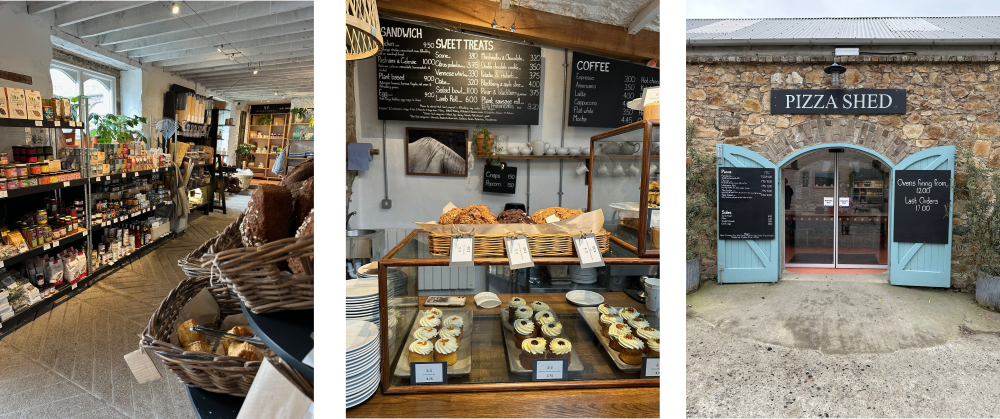
The café adjoins the farm shop offering freshly baked cakes and scones made by the restaurants’ pastry chef. Further along in the same pavilion of buildings once used to house a dairy and stables is The Pizza Shed, which has just undergone an extension and upgrade after proving its popularity with locals, especially during weekends. A Farmer’s Market every Saturday is an eclectic mix of local food, arts, craft and antiques that perfectly compliments the relaxed atmosphere of the courtyard space.
But the jewel in the crown is Executive Head Chef Niall O’Sullivan’s The Grain Store Restaurant. O’Sullivan is a chef relishing the abundance of Killruddery’s organic produce from farm and gardens with menus driven by provenance and seasonality – last summer, 95% of the produce on menus was sourced directly from the farm and gardens of the estate managed by head market gardener, Pat Keady. As a founding member of Nadúr Collective, O’Sullivan’s dishes are frequently complimented with wild foraged elements, and a passion for preservation and fermentation deliver sensational little taste bombs. The restaurant operates Thursday to Sunday for lunch and dinner, with seasonal supper clubs on Friday and Saturday evenings. This is the place to be any time of year, but particularly on balmy summer evenings when pretty festoon lights illuminate the courtyard making you feels as though you are a million miles from anywhere.
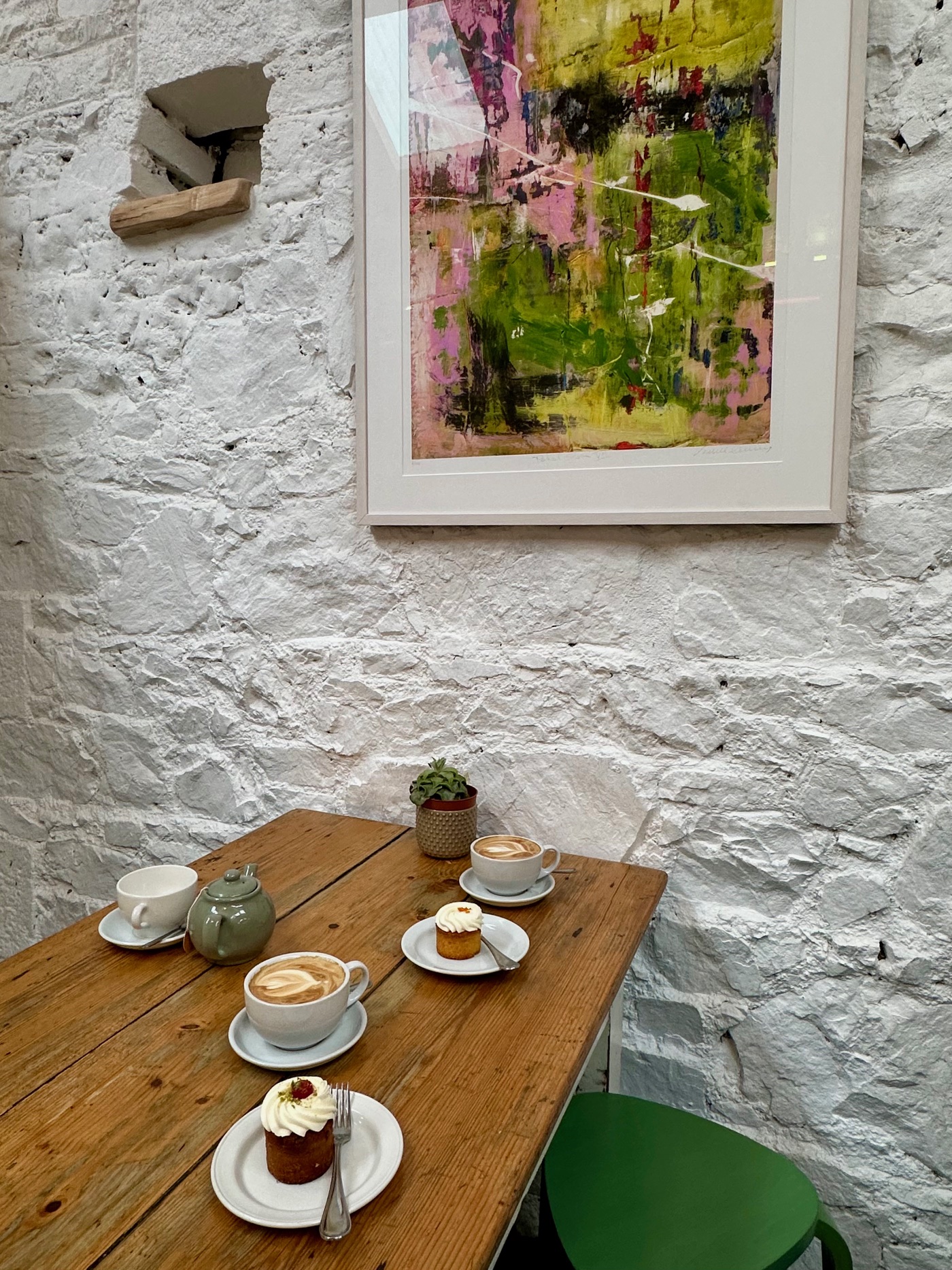 When touring Killruddery Gardens, a final pit stop is the octagonal former dairy turned tearoom Here, once upon a time, milk and cream would be brought into this ornate room to chill and separate for making butter. In its heyday this building was, truth be told, largely unnecessary, but it reinforced the spectacle of these houses to show off what could be produced on the estate. Today, this is where guests come to take a moment of refreshment after a tour of the gardens. Fresh dairy still features heavily in frothy coffees and milky teas to accompany a freshly baked scone topped with butter and cream.
When touring Killruddery Gardens, a final pit stop is the octagonal former dairy turned tearoom Here, once upon a time, milk and cream would be brought into this ornate room to chill and separate for making butter. In its heyday this building was, truth be told, largely unnecessary, but it reinforced the spectacle of these houses to show off what could be produced on the estate. Today, this is where guests come to take a moment of refreshment after a tour of the gardens. Fresh dairy still features heavily in frothy coffees and milky teas to accompany a freshly baked scone topped with butter and cream.
The guiding principle of the “Killruddery Kitchen Table” is to honour the estate and people in service of place. This is what makes the food experiences here so intriguing but also authentic and deeply steeped in the food customs and traditions of the estate itself.
RUSSBOROUGH HOUSE (Blessington, West Wicklow)
www.russborough.ie
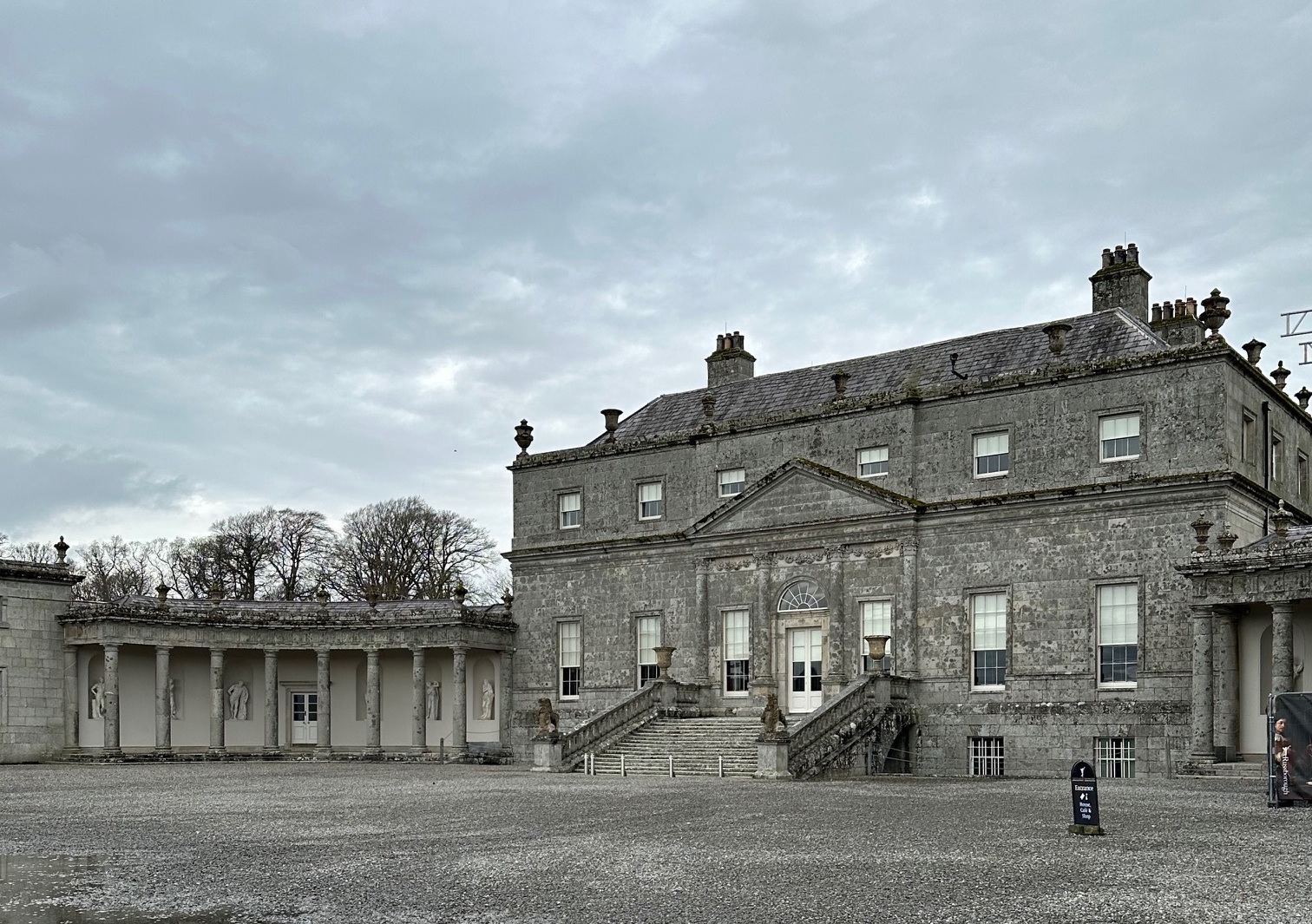 Russborough House is primarily known and renowned for its art collections as well as many of the finest examples of furniture and decorative interiors in Ireland. The art itself is the foundation for a colourful past, including several art heists. A large proportion of the collection was accumulated during a Grand Tour by the original founder of the house, the Earls of Milltown (formerly the Leeson family), who traded up to the 200-acre demesne funded by great wealth acquired through his family’s merchant roots – mostly in brewing, tanneries and property.
Russborough House is primarily known and renowned for its art collections as well as many of the finest examples of furniture and decorative interiors in Ireland. The art itself is the foundation for a colourful past, including several art heists. A large proportion of the collection was accumulated during a Grand Tour by the original founder of the house, the Earls of Milltown (formerly the Leeson family), who traded up to the 200-acre demesne funded by great wealth acquired through his family’s merchant roots – mostly in brewing, tanneries and property.
Joseph Leeson needed to learn how to be a gentleman in order to conduct himself in a manner befitting a gentleman of wealth and privilege. During his Grand Tour, Leeson collected and commissioned great works of art with which to fill his great Georgian Palladian mansion as a conspicuous display of his wealth and status. Guided tours of Russborough detail the story of the rise of Russborough House through the lives of the three families who have been custodians of the house since 1755.
 The estate boasts a 3-acre walled garden which was established soon after completion of the main house in 1760. The walled garden is in the care of the Royal Horticultural Society of Ireland and worked by a band of some 15-20 volunteers three days per week. It’s home to a handful of apple trees as old as 200 years still producing great tasting cooking apples, soft fruit bushes of all kinds (gooseberries are a speciality), and vegetable crops grown throughout the year. The produce from the garden is made into seasonal preserves and condiments sold in the gorgeous IMAGE 8D gift shop producing a small income for the estate. Cut flowers and pot plants grown by the volunteers are also sold with funds going back into maintaining the walled gardens and its old glasshouse structures.
The estate boasts a 3-acre walled garden which was established soon after completion of the main house in 1760. The walled garden is in the care of the Royal Horticultural Society of Ireland and worked by a band of some 15-20 volunteers three days per week. It’s home to a handful of apple trees as old as 200 years still producing great tasting cooking apples, soft fruit bushes of all kinds (gooseberries are a speciality), and vegetable crops grown throughout the year. The produce from the garden is made into seasonal preserves and condiments sold in the gorgeous IMAGE 8D gift shop producing a small income for the estate. Cut flowers and pot plants grown by the volunteers are also sold with funds going back into maintaining the walled gardens and its old glasshouse structures.
Given the size of the estate, Russborough have struck up mutually beneficial relationships like the one with RHSI to create exciting activities and ways for the public to come and experience this beautiful place in extraordinary ways. The National Bird of Prey Centre is based in Russborough, as are artist studios, sheepdog demonstrations, and a range of outdoor activities for kids of all ages (even adult-sized ones) via CP Adventure.
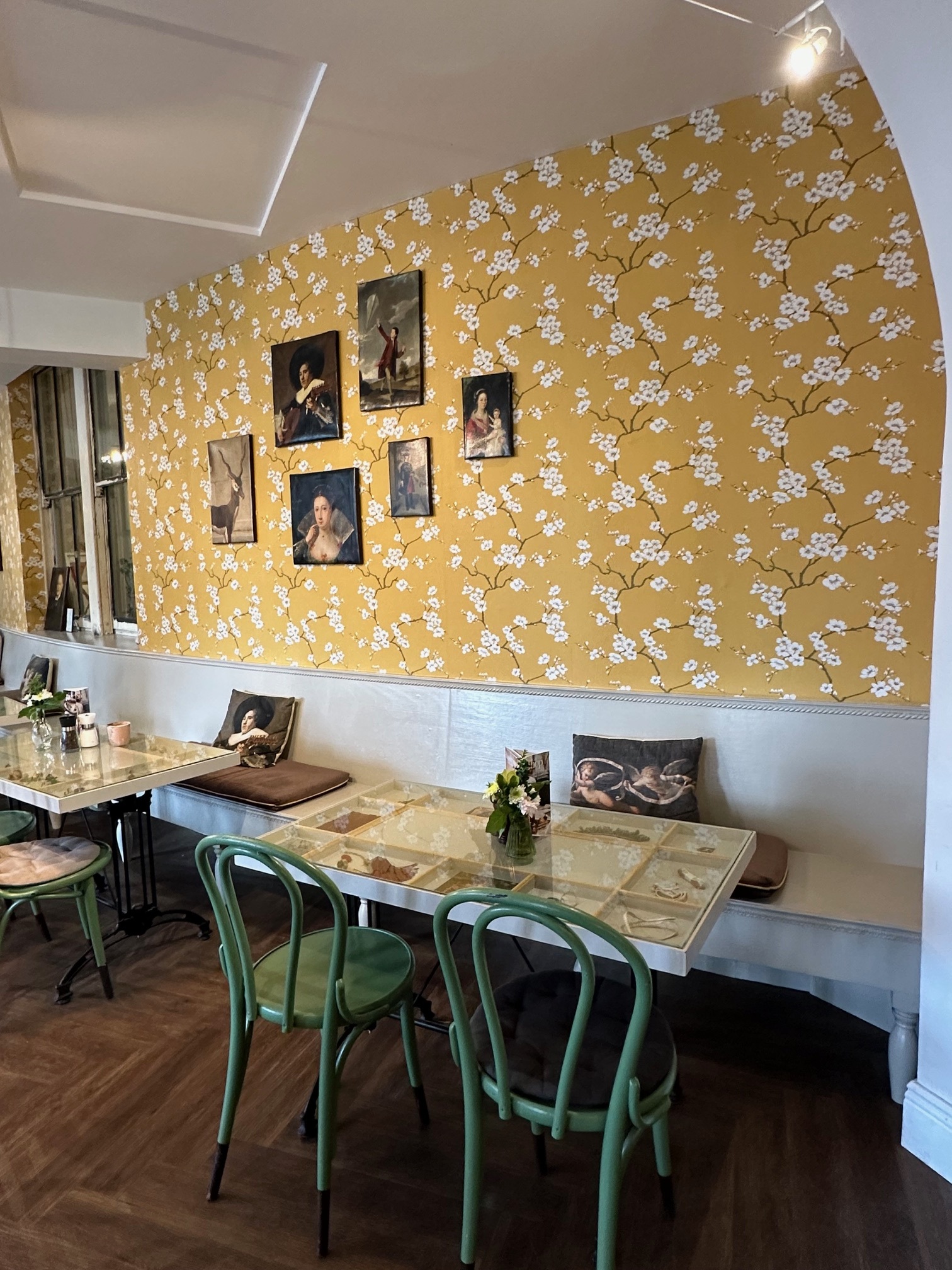 Inside Russborough House is an onsite café operated by Gather & Gather which prioritises using as much local and seasonal produce as possible. It’s a popular spot and, despite the age of the property, is entirely wheelchair accessible. Fresh salads, sandwiches, quiches and savoury bakes alongside a small selection of hot dishes and cakes are made fresh daily onsite by the kitchen team. (Top Tip: the Bread and Butter Pudding is made from freshly baked croissants and is something of a signature dish at the café!) Afternoon Tea is a particular fan favourite with regulars and visitors alike and a fittingly elegant way to complete a day's exploration around the house and gardens.
Inside Russborough House is an onsite café operated by Gather & Gather which prioritises using as much local and seasonal produce as possible. It’s a popular spot and, despite the age of the property, is entirely wheelchair accessible. Fresh salads, sandwiches, quiches and savoury bakes alongside a small selection of hot dishes and cakes are made fresh daily onsite by the kitchen team. (Top Tip: the Bread and Butter Pudding is made from freshly baked croissants and is something of a signature dish at the café!) Afternoon Tea is a particular fan favourite with regulars and visitors alike and a fittingly elegant way to complete a day's exploration around the house and gardens.
Throughout the year, Russborough hosts concerts, events, workshops and festivals (including the family-friendly Kaleidoscope festival). For certain events, special pre-show suppers are served in the café and make a magical start to any evening in the surrounds of this great house.
The many acres of beautiful parklands, formal gardens, meadows, lakes and wild hedges have been carefully managed and are now a biodiversity hotspot for wildlife. Otters, moorhens, herons, snipes, barn owls, bats, swans, ducks, hares, dormice, foxes, badgers, red squirrels and bees have all made Russborough’s diverse and protected landscapes their own. (Fun Fact: 52 of the 100 species of wild bee have been identified on the estate.)
Russborough’s connection with food, however, comes into its own in the way past owners gave primacy to the skill and craft of hospitality. Ireland’s great houses were often first at the races when it came to fashion. Food has always been a windsock in this regard because, aside from sustenance, food was always about status. For instance, in the walled garden there is a Pits House, a semi-sunken glasshouse used for growing exotics and tropical plants. Pineapples were first introduced to Europe in the 16th century, and by the time of Russborough’s heyday they had become unlikely edible object d’art for the very rich. At one time it was said that pineapples were more valuable than gold, which is why pineapples appear as decorative gold-plated objects in abundance in the Georgian era. Pineapples could even be rented as decorative centrepieces to be admired but never eaten. For those wishing to really showcase their wealth, the pinnacle of pineapple grandstanding would be to shoulder the enormous cost of growing one’s own pineapple in Pits Houses heated through underground pipes fired by a boiler. The remainder of all these elements are found in the Russborough Pits House in the walled garden.
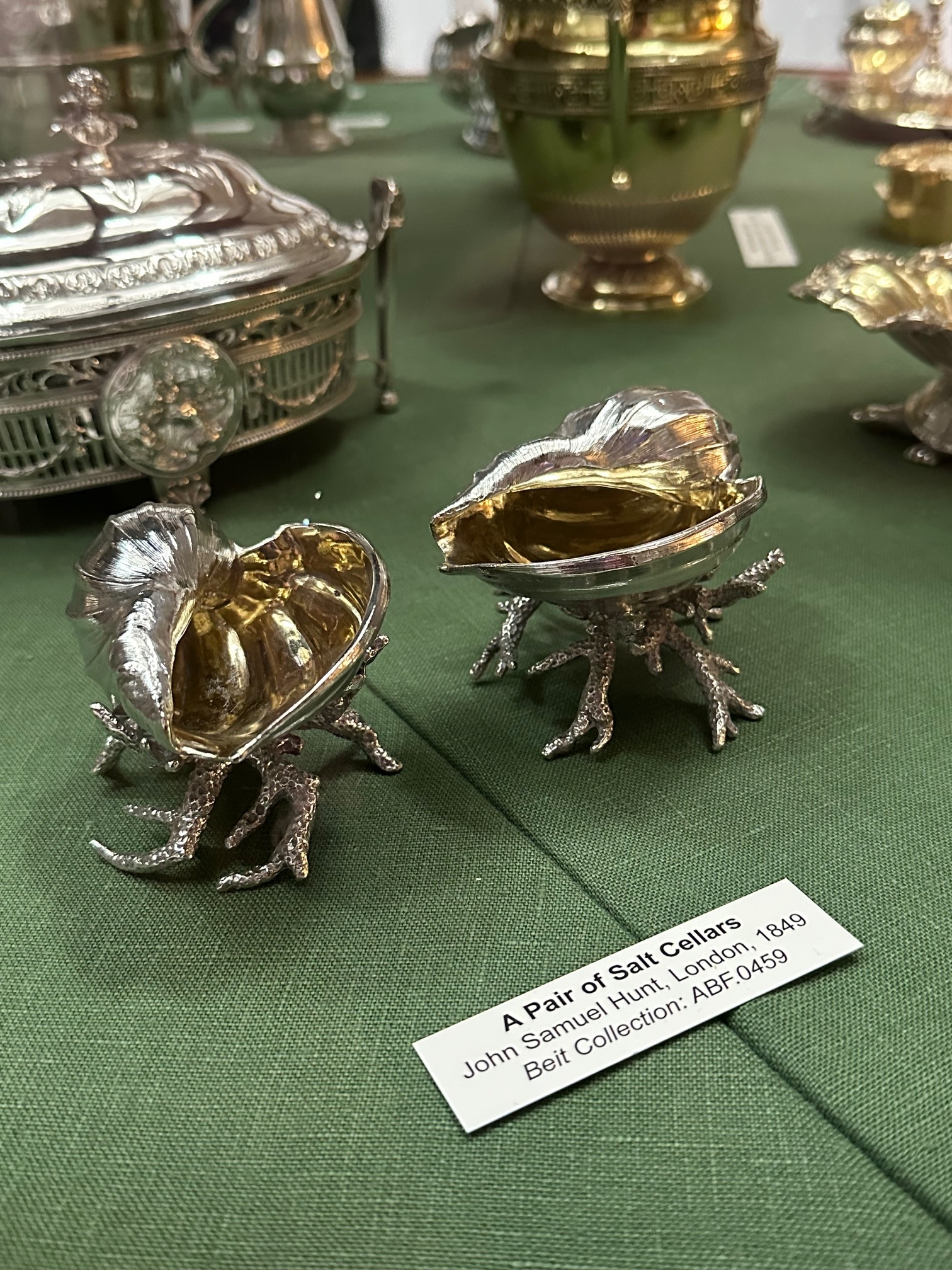 In addition, Russborough has the largest private collection of silver and porcelain in Ireland. These items weren’t just for display but vital in underpinning the status of the house at the most show-off-y time of all – mealtimes. In the archives of the house, manuscript books and diaries are filled with the detailed records of every element of hospitality employed by the Milltown/Leeson family. Remember, the first Earl had invested huge energy in learning how to be a gentleman and therefore knowing who was coming to dinner and their respective rank and status informed decisions around which silverware, crockery and glassware were to be used. The accoutrements of dining were purposefully selected with the choice of dishes for each menu. Where notes on pineapples feature, it is only for the most esteemed of guests and occasions.
In addition, Russborough has the largest private collection of silver and porcelain in Ireland. These items weren’t just for display but vital in underpinning the status of the house at the most show-off-y time of all – mealtimes. In the archives of the house, manuscript books and diaries are filled with the detailed records of every element of hospitality employed by the Milltown/Leeson family. Remember, the first Earl had invested huge energy in learning how to be a gentleman and therefore knowing who was coming to dinner and their respective rank and status informed decisions around which silverware, crockery and glassware were to be used. The accoutrements of dining were purposefully selected with the choice of dishes for each menu. Where notes on pineapples feature, it is only for the most esteemed of guests and occasions.
All of this detailed decision making was meticulously recorded in books along with dates, times of arrival and departure, and any other snippets of information that would both cement the reputation and standing of the Leesons (likely underpinned by a fear one misstep in etiquette or custom could expose his bourgeois past) and meet the expectations of hospitality and deference required of his guests.
While on a visit, I was fortunate to be shown some of these priceless manuscripts by Pauline Swords, head of collections and conservation at Russborough House. A recipe that stood out was for the simplest of things - how to make coffee. The recipe book was created by Lady Clementine Mitford (1854-1932) - Neé Ogilvy, grandmother of Clementine Beit:
"Take equal quantities of Mocha and Cuba coffee. Roast the first of a pale colour, and the latter very dark, almost burnt. Boil the water (river water if possible) in a very clean saucepan and when boiling pour into the coffee-pot a small quantity at a time. If possible, use the coffee freshly roasted and always use it freshly ground."
Count Karolyi's cook. 1880
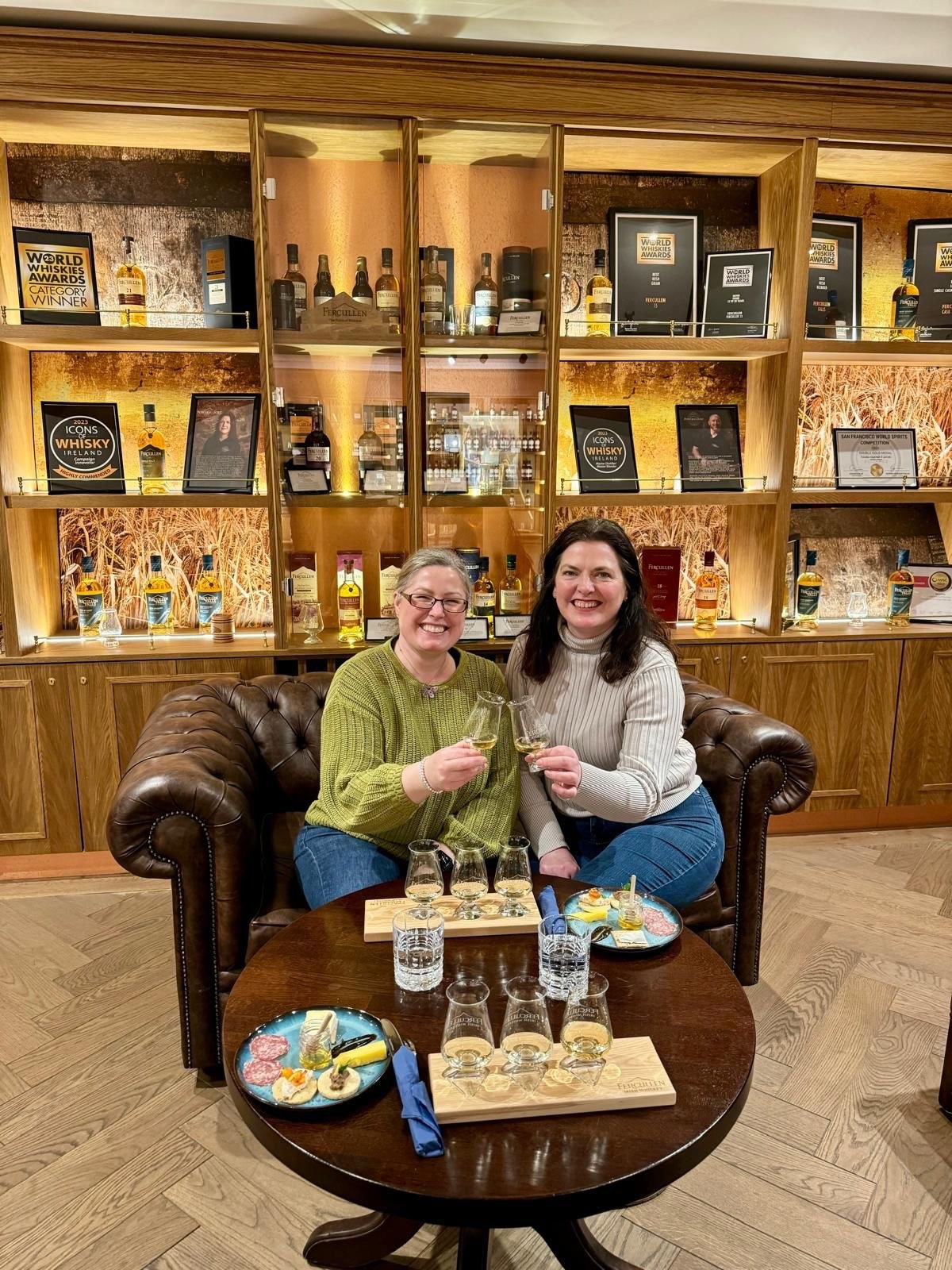
*** Many thanks to Santina Kenndy (Visit Wicklow: www.visitwicklow.ie and Wicklow Naturally: https://wicklownaturally.ie/), pictured (right) with Kate Ryan at Powerscourt Distillery, for her expert guidance on this wonderful Wicklow adventure.




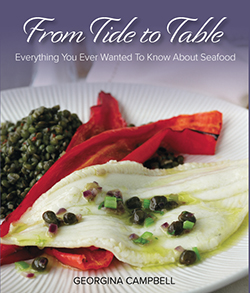
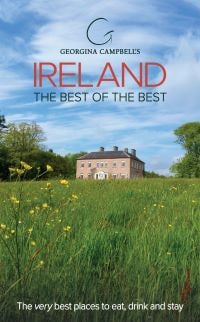
There are currently no comments
Leave a comment
Not a member? Register for your free membership now!
Or leave a comment by logging in with: